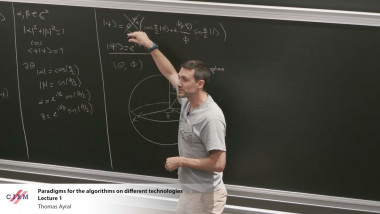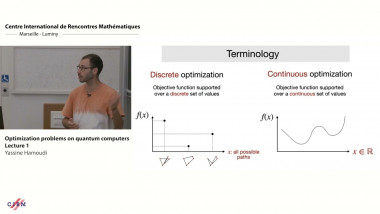
Paradigms for the algorithms on different technologies - lecture 1
By Thomas Ayral

Optimization problem on quantum computers - lecture 1
By Yassine Hamoudi
By Toby Cubitt
Appears in collection : 2017 - T3 - WS3 - Quantum information theory
Physical (or "analogue") Hamiltonian simulation involves engineering a Hamiltonian of interest in the laboratory, and studying its properties experimentally (somewhat analogous to building a model of an aeroplane and studying it in a wind tunnel). This is often touted as the most promising near-term application of quantum computing technology, because (it is claimed) it does not require a scalable, fault-tolerant quantum computer. Despite this, the theoretical basis for Hamiltonian simulation is surprisingly sparse. Even a precise definition of what it means to simulate a Hamiltonian was lacking. By drawing on techniques ranging from Hamiltonian complexity to Jordan algebra homomorphisms, we put analogue Hamiltonian simulation on a rigorous theoretical footing. This is far more fruitful than a mere mathematical tidying-up exercise. In work with Gemma de las Cuevas [Science, 351:6278, p. 1180, 2016], we used this new theoretical insight to prove for the first time that there exist universal spin models that are capable of simulating any other classical spin system, and showed that the simple 2D classical Ising model with fields is such a universal model. In recent work with Ashley Montanaro and Stephen Piddock [arXiv:1701. 05182], we extended these results to the mathematically more challenging quantum case. First constructing a rigorous theory of quantum Hamiltonian simulation, then proving a complete classification of the simulation power of two-qubit interactions, showing that even simple models such as the 2D Heisenberg model are universal quantum Hamiltonians. Along the way, we took a first step towards rigorously justifying why error correction may not be necessary in Hamiltonian simulation. As well as the obvious practical applications, our classification result encapsulates and strengthens a large fraction of known Hamiltonian complexity results, and our universal Hamiltonian results have implications for the (non-)role of symmetries, spatial dimension and locality in fundamental physics.
